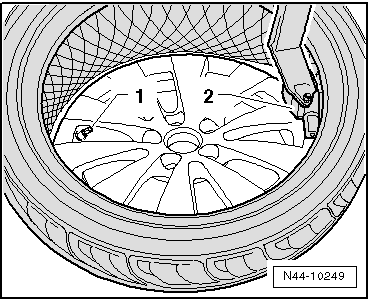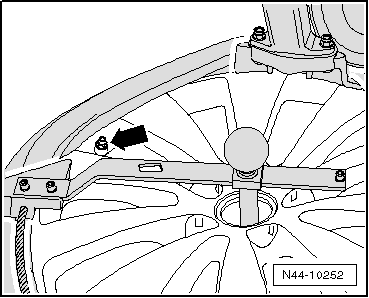Volkswagen Polo Service & Repair Manual: Tires, Mounting, Run-Flat Tires and Ultra High Performance Tires
| Only trained personnel can perform the assembly work on
run-flat tires and ultra high performance tires. |
| If equipped check the tire pressure monitoring sensor with
the vehicle diagnostic tester and if necessary replace. |
| – |
Bring the tires to the mounting temperature. Refer to
→ Chapter „Tires, Bringing to Mounting Temperature“. |
 Note Note
| If equipped handle the glued-on wheel trim carefully.
Surface slightly scratched. |
| Replace the damaged rim wheel trim. |
| – |
Insert new tire valve with Valve Fitting Tool -VAS6459-. |
| – |
Coat rim flanges, tire beads and inside of upper tire beads
thoroughly with tire mounting paste. |
| – |
Place the inner side of the tire on the rim. |
|
|
|
| – |
Turn the rim until the tire valve of the tire pressure
monitoring sensor aligns with the mounting head. |
|
|

|
| – |
Let the tire dismounting/mounting machine run clockwise
until the mounting head is in front of the tire valve or the
tire pressure monitoring sensor -arrow-.
Slide the lower tire bead over the rim flange. |
|
|

|
| – |
Turn the rim until the tire valve of the tire pressure
monitoring sensor -1- aligns with
the mounting head -2-. |
| – |
Install the hold-down device -3-
on the rim. |
|
|

|
Only trained personnel can perform the assembly work on
run-flat tires.
If equipped check the tire pressure monitoring sensor with
the ve ...
If necessary repair flat spots from standing. Refer to
→ Chapter „Flat Spots, Correcting“.
–
Dismount the tire. Refer to ...
Other materials:
Fitting the removable ball coupling
Fig. 91 Overview: removable ball coupling
First read and observe the introductory information
and safety warnings
The removable ball coupling is located under the luggage compartment floor with
the vehicle toolkit.
Key for :
Cap
Ball coupling
Retaining balls
Catch for locking ...
General Information
The following descriptions also apply to Left Rear Cigarette
Lighter -U3-, Right Rear Cigarette Lighter -U7-, Rear Cigarette
Lighter -U9-, 12 V Socket 2 -U18-, 12 V Socket 3 -U19-, 12 V
Socket 4 -U20-, Cigarette Lighter 2 -U25- and 12 V Socket 5
-U26- if ...
A/C Service Station, Connecting for Measuring and Testing
Caution
If it is suspected that chemicals were added to the
refrigerant circuit to seal leaks, do not connect the
A/C service station and do not extract the refrigerant.
...
© 2016-2026 Copyright www.vwpolo.net

 Note
Note Note
Note Tires, Mounting, Wheels without and with Tire Pressure Monitoring System
Tires, Mounting, Wheels without and with Tire Pressure Monitoring System Tires and Rims, Matching
Tires and Rims, Matching



 Caution
Caution